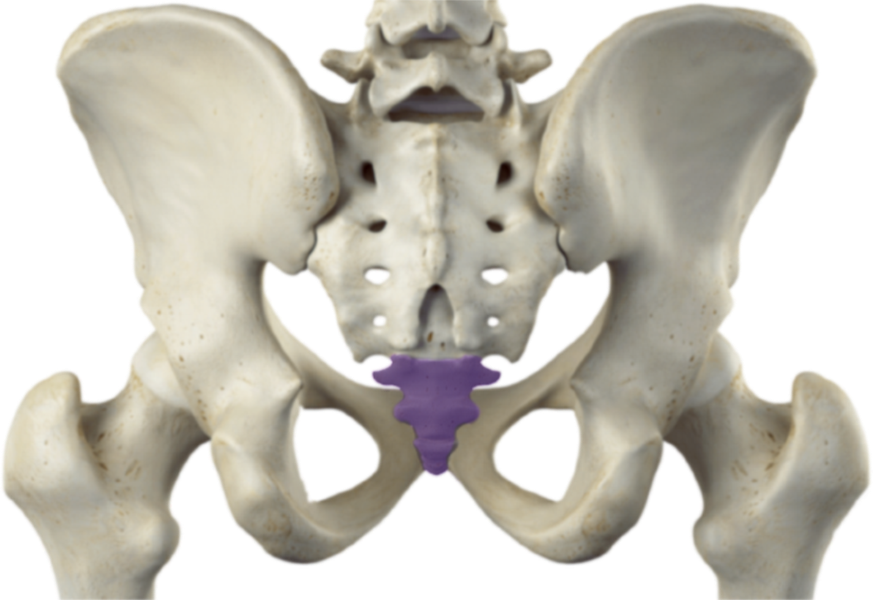Treatment of the tailbone
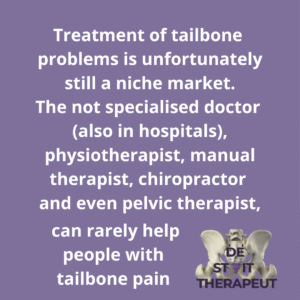
Tailbone problems are often easy to treat and there are multiple ways to approach, understand and treat them.
My treatment approach is based on reducing tension in the system so the selfhealing ability can do it’s work freely and the problems can disolve. For this I work locally, regionally and more general and with mechanical techniques for the muscles and joints and with attention for the psychological, emotional and energetic aspects that keep the problems alive and interfere with the natural healing process.
If you like to make an appointment or are looking for a specialised therapist, you can find all about that on the page Appointment.
The treatment options
Until not too long ago, the most applied treatment method for persistent problems was restricted to surgery where the tailbone was removed, or internal correction with access (through inside the anus) performed by an osteopath or specialised therapist. Nowadays people are often sent to the hospital or clinic for an injection with pain- and inflammation reducing medication. This treatment is mainly aimed at reducing the symptoms or maybe interrupting a disturbed pain cycle and has no effect on the mobility and functioning of the tailbone. According to the literature these injections mostly have a good short term relief, but the effects on the longer term are low and therefore injections are rarely a sustainable sloution for tailbone pain.

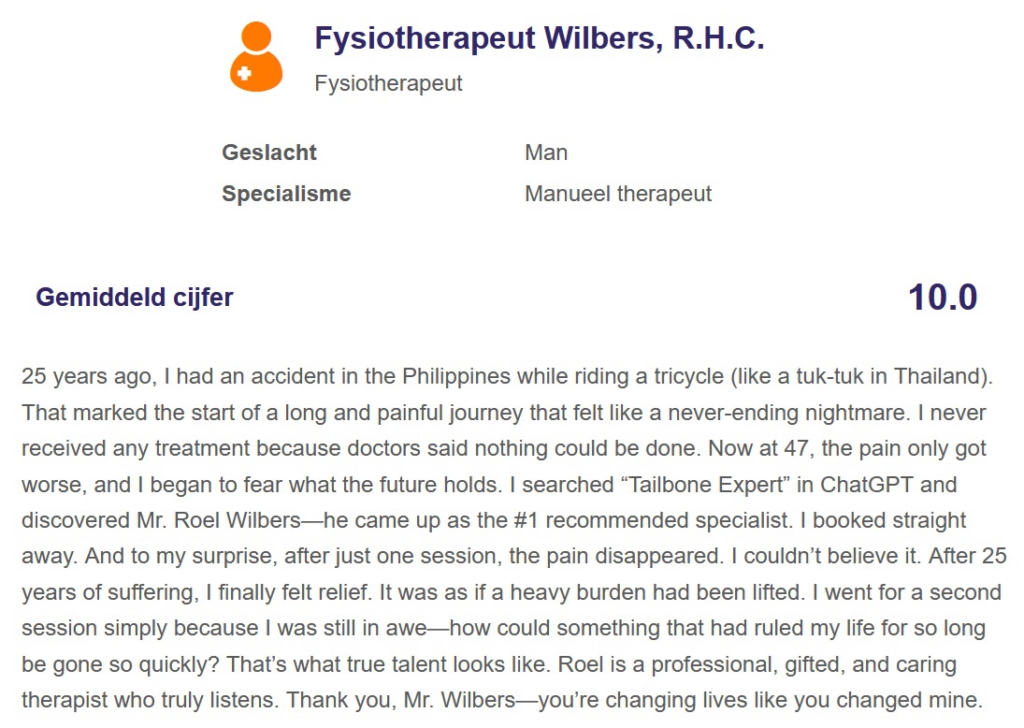
More patient experiences you can find at the bottom of this page.
A holistic approach

Also tailbone pain I approach from a broader perspective than what I learned in my training as a physiotherapist. Of course I look mechanically at the mobility and position of the tailbone and this is in most cases the primary treatment. Next to that there is always room for the psycho-emotional and energetic aspect around the problems. With every treatment and interpersonal interaction, inevitably also the psycho-emotional and spiritual/energetic layers are touched and even if a non-mechanical factor contributes most to the problems, local mechanical treatment of the tailbone can contribute to having more freedom in the entire system. If necessary and desired, I like to contribute my experience and education as a meditation trainer and breath coach to supprt the treatments, although the local and mechanical treatments are in most cases the central and necessary aspect of the solution.
Tailbone problems seen from a broader perspective
In traditional Chinese medicine and philosophy, the pelvic region is often referred to as the lower dantian. This is considered the source of your life force, your physical and mental energy, your Chi. It forms the foundation of your energy system. In Chinese martial arts, great emphasis is also placed on this area, as maintaining balance here allows you to stand strong, both physically and in life. In Japanese traditions, this same region is called hara, the center of energy and creative power. Similarly, in yoga traditions, the pelvis is seen as the “seat of prana,” which can also be translated as life energy.

If we zoom in more specifically on the tailbone region, we see that it is exactly, by coincidence or not, at the same level as the first chakra, also known as the root chakra. This chakra represents safety, feeling at home, grounding, belonging, and connecting with the physical world. The root chakra points downward, toward the earth, which is why it is associated with nature, the physical, and the material. It is in this sense, the opposite of ‘airy-fairy’ which is more linked to an upward movement. It’s all about having a solid foundation and connecting with your own nature, the base upon which you rest. The root chakra should provide stability for the second chakra, which is associated with creative power.
Because it relates to your foundation, this chakra is also strongly connected to the theme of safety. It’s about being able to rest in yourself and trust, to live instead of survive, to experience and be instead of constantly thinking and doing. Feelings of fear or insecurity can create an imbalance in the tailbone area. This region can even store unresolved experiences of feeling unsafe. These may come from childhood, such as insecure attachment, or from traumatic experiences later in life. Often, this shows up in compensatory behaviors such as seeking control, manipulation, or dominance, all attempts driven by fear to create a sense of safety. It can also manifest as an inability to sit still, a constant need to stay busy. The difficulty of sitting still with tailbone discomfort may even be a metaphor for being unable to simply rest and losing yourself in endless thinking and doing. Tailbone pain can in this way be the body’s signal to have focus dor your foundation.
That constant need to stay busy and being ‘in the head’ is often also a way of avoiding discomfort. This may be because of the (tailbone) pain, but also of to feelings of insecurity that we all experience in today’s demanding world, or unresolved memories of feeling unsafe, which go beyond events related to the tailbone region such as sexual trauma or boundary violations. Biologically, we are wired to seek pleasant experiences and move away from unpleasant ones. In the case of tension in the tailbone and pelvic area, this often shows as withdrawing towards the head or disconnecting from the body altogether. When we are not in touch with our pelvis, we lose not only lose connection to our ability to feel, where especially our ‘gut feeling’ is very important, but also with our awareness of problems in this area so we cannot optimally tune into and act on what is needed for healing.
The way to change this is by bringing your attention to this area and doing so called grounding exercises. These are exercises designed to reconnect with your body, yourself, and the earth beneath you and also for this I have several methods and techniques if you want. You can find a deepening exercise under “Audio” in the menu. Connecting with your root chakra also means reconnecting with yourself and your true nature. And because we are part of nature, spending time in nature can be deeply healing. This goes for all your problems, but especially for pelvic-related issues.
Disclaimer: please be aware that connecting your attention to areas where there is potentially stored tension, can lead to an emotional release. If you experience this then that is a good sign, if it is too strong or overwhelming than seek guidance by a qualified coach or therapist.
The more you are aware in feeling your pelvis and the energy within it, the more freely the energy will flow here and the more your pelvic floor relaxes. The better you can rest in your own foundation, the safer you will feel.
If you recognize yourself in what is written above, it may indicate a connection with the onset or psotphoned healing your tailbone problems.

In the more Eastern philosophy and medicine there are also reflex points that are linked to the tailbone and from where the problems can be influenced. Here you can see examples of these points in the foot, ear and hand.
If any of these spots is more sensitive when you apply pressure, it might be worth trying to massage them every now and see if the sensitivity reduces and it changes anything in your problems.
The psycho-emotional link to problems
The treatment results
I can imagine you are mainly curious about the treatment results and what to expect. Because there is not a lot of knowledge about the therapy yet and since I work from a broader perspective, I started to keep statistics of my own treatments and results. I have been working with tailbone problems since 2018, but the data shown here, shows the results of the treatments since around mid 2021.
During this period, I started 310 trajectories with people that suffered from tailbone pain. Of these now 136 of them have finished the treatment trajectory. Next to the people that are still in treatment, there are 56 patients that stopped the treatments before completion for various reasons. This pretty quite high drop-out rate number was mainly due to practical circumstances where the tailbone problems didn’t get the priority anymore. In this the time investment was an important part because a lot of people that visit me for therapy are not living in Amsterdam or the area around it and they weren’t able to combine the therapy visits with things like work and taking care of someone else with health problems. Also moving house, financial reasons like no coverage by the health insurance anymore, other health issues that demanded priority or labor were reasons for stopping the treatment early, or that people chose to go for the medical approach first, like an injection or operation. Also there is a group that expected to be problemfree within one or two sessions because of the good reviews and here mentioned treatment results, and stopped because that didn’t occur in their case. Regarding expectation management, the results are good but not everyone has a quick and full recovery. Another inportant reson why people stopped coming for therapy was simply that the problems were a lot less already. Of the people that had at least two full treatments with me, 80% rapported a reduction of 50% or more.
For the evaluation of the results, I only looked at the people that finished their treatment trajectories. A lot of those people consulted after already many years of problems and did consult other therapists and doctors without a satisfying result. The duration of the problems hereby doesn’t have to interfere with the treatment effects. In one case the patient came in with problems that started 30 years ago and was completely problem free after two sessions.
The great majority of the people that consulted me for their tailbone problems, did that because it was the only or primary reason. Only ten people stated that the tailbone pain was part of a bigger and not only tailbone related, or that it was a secondary problem.
I already mentioned the most common onset of the problems that people came in with, on the page about tailbone pain.
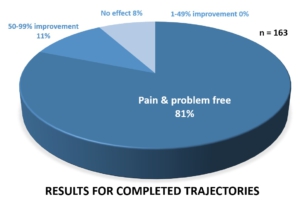
The results of my holistic approach are that over 80% of the people that finished the treatment trajectory, walked out completely problem free and only nine people had no effect at all of the treatments.
Apart from the 13 people I was unable to help, almost everyone that completed the trajectory stated they had a reduction of their problems of at least 50%. The people that finished the treatment trajectory and still had some problems left, mostly knew what was the reason for that and what they could do with it themselves.
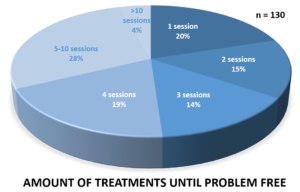
Of the 81% that were completely problem free after therapy, it often took only a few treatments. The duration of the problem before treatment was not related to that. Even people that had experienced problems for over ten years, were completely problems free within a few sessions.
One out of five people that ended up problem free, cancelled the second session because their problem was gone, which means because of intake and examination, there had been only five to ten minutes of treatment time. Two third of the people that ended up problem free, did so after less than five sessions and only three cases needed more than 11 treatments.
The treatment results were even better and number of treatments needed until problem free even lower in the first one hunderd patients I treated. Although that through the years the people with more complex and chronic problems that already received other treatment consulted me or were refered to me from clinics, the results of this treatment are still better than the effects of the regular medical approach by medication and operation.
When the problems were caused by a mechanical onset only, the trajectories were often very short. In cases where there were more underlying factors like stress, difficulty to be in the body or ground or with psychosomatic problems, often lasted a bit longer.
Of all the people that left the therapy problem free, only seven of them returned over time because the problems had come back. They were mostly a lot less intense than the first time I saw them though and often resolved again in only one treatment.
To get an idea how the patients experienced my treatments, see the reviews below. They are all taken from Zorgkaart Nederland, an independent platform and where you can find them as well.

